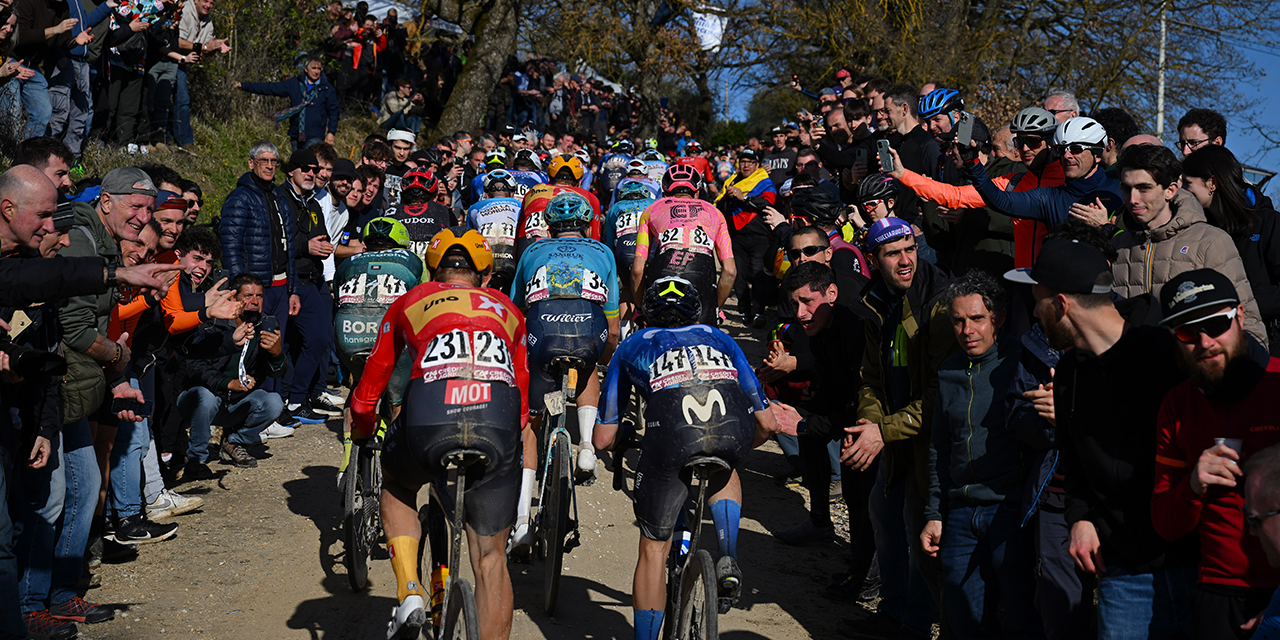The gravel sectors of Colle Pinzuto (2.4 km of pure climbing with ramps up to 15%) and Le Tolfe (1.1 km, including a brutal 500-meter ramp at 18%) have historically been the last off-road battlegrounds of Strade Bianche. Since 2024, these punishing sectors have become even more crucial, as the race now features a circuit that forces riders to tackle them twice. Packed into just 7 km, they first appear with 42 km to go, before riders hit the short Strada del Castagno (700m) and Montechiaro (3.3 km) gravel sectors, only to return for a second showdown on Colle Pinzuto and Le Tolfe with just 12 km to go.
Needless to specify that these are prime spots for fans, especially with the double passage providing twice the drama. By this point, the big names have usually begun their battle, and attacks are flying. However, despite their undeniable difficulty and key position in the race, history shows that only a handful of editions have seen the winning move launched from Colle Pinzuto or Le Tolfe. In fact, in 17 editions of Strade Bianche, decisive attacks on these sectors can be counted on one hand.
Until 2011, “Europe’s southernmost Northern classic” was a less selective race, often decided on the final ramp of Via Santa Caterina, the brutal cobbled climb into Piazza del Campo, Siena. That changed in 2012, when Fabian Cancellara used Le Tolfe as the starting point of his legendary solo victory. Michal Kwiatkowski pulled off a similar move in 2014, though he delivered his winning attack just after the climb, on the tarmac. The mud-soaked 2018 edition saw Tiesj Benoot go on the offensive on Colle Pinzuto, bridging to Wout Van Aert and Romain Bardet, before dropping them on Le Tolfe to claim an epic solo win. In 2020, during the scorching August edition post-pandemic, Wout Van Aert made his move on Colle Pinzuto and rode alone to victory.
In the women’s race, Anna van der Breggen distanced the field on Colle Pinzuto in 2018, while Annemiek van Vleuten chose Le Tolfe as her launchpad in both 2019 and 2020.
For most of its history, the final Via Santa Caterina ramp remained the decisive moment, with Colle Pinzuto and Le Tolfe serving more as selection points rather than race-winning sectors. But cycling has changed. In the past three years, aggressive, long-range attacks have rewritten the script.
Since 2022, the Monte Sante Marie sector has become the real turning point. Tadej Pogačar was the first to launch a long-range solo attack over 50 km from the finish, a move repeated in 2023 by Tom Pidcock. Then, in 2024, the Slovenian prodigy pushed the limits even further, attacking an astonishing 80 km from Siena, ignoring the fact that the revised course placed Monte Sante Marie even farther from the finish, and still managing to ride solo to victory.
In the women’s peloton, however, the pattern has remained somewhat unchanged. The final climb of Via Santa Caterina continues to be the ultimate decider, with Chantal Van Den Broek-Blaak (2021), Lotte Kopecky (2022 and 2024), and Demi Vollering (2023) all winning with decisive moves in Siena.
If all goes as expected, Pogačar will attend the upcoming 2025 edition as well. Will he attempt another long-range demolition on Monte Sante Marie, or could Colle Pinzuto and Le Tolfe once again become the launchpads for victory, as they were in 2012, 2014, 2018, and 2020?



































